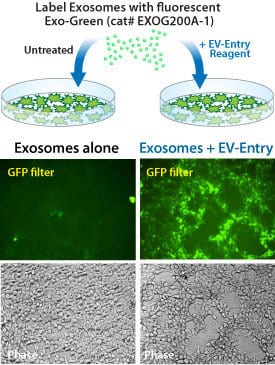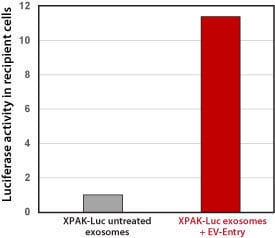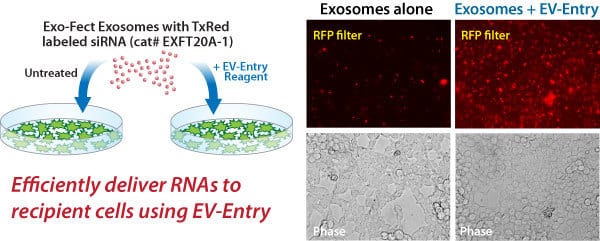EV-Entry System
- Fast—the protocol takes less than one hour to complete
- Easy—just add the two reagents to your exosomes, incubate at room temperature, and add to recipient cells
- Powerful—greatly enhances the ability of exosomes and other EVs to deliver protein and RNA cargo to recipient cells
Products
| Catalog Number | Description | Size | Price | Quantity | Add to Cart | |||
|---|---|---|---|---|---|---|---|---|
| EVEN105A-1 | EV-Entry System for Exosome Delivery | 5 Reactions | $309 |
|
||||
| EVEN110A-1 | EV-Entry System for Exosome Delivery | 10 Reactions | $606 |
|
||||
Overview
Overview
Putting exosomes to work: Improving exosome-mediated cargo delivery
Get better exosome-mediated cargo delivery with the EV-Entry System. This easy-to-use two-component reagent system not only increases the rate at which recipient cells take up exosomes and other extracellular vesicles (EVs), it also increases offloading of the transported cargo into the cytoplasm of the recipient cells, whether that cargo is RNA or protein.
- Fast—the protocol takes less than one hour to complete
- Easy—just add the two reagents to your exosomes, incubate at room temperature, and add to recipient cells
- Powerful—greatly enhances the ability of exosomes and other EVs to deliver protein and RNA cargo to recipient cells
References
How It Works
Supporting Data
Supporting Data
See how well the EV-Entry System enhances exosome-mediated cargo delivery
The EV-Entry System increases the efficiency of exosome-mediated delivery of proteins to target cells.
In Figure 1, Exo-Green is used to label exosomal proteins, and then EV-Entry enhanced transfer of Exo-Green-labeled exosomal proteins to recipient cells is monitored using fluorescence microscopy. In Figure 2, enhanced transfer of a specific exosomal protein—XPack-Luciferase (Cat.# XPAK732PA-1)—is shown. In both cases, the EV-Entry System increases the amount of cargo delivered.
Figure 1. The EV-Entry System enhances delivery of Exo-Green-labeled exosomal proteins to recipient cells. Exosomes were labeled with Exo-Green and added to HEK293 cells with or without the EV-Entry reagent, and cells imaged after 18 hours. Cells that received exosomes with the EV-Entry reagent showed remarkably enhanced uptake of exosomes and release of exosomal cargo into the cytoplasm as demonstrated by the staining pattern of exosomal proteins in the recipient cells using a very brief exposure time.
Figure 2. The EV-Entry System enhances delivery of XPack-Luciferase to recipient cells. HEK 293 cells were transfected with XPack-Luciferase, exosomes were harvested, and then these XPack-Luciferase-containing exosomes were added to naive HEK 293 cells with or without the EV-Entry reagent. After 18 hours, target cells were washed multiple times with PBS, lysed and luciferase activity measured. Cells that received XPack-Luciferase exosomes treated with the EV-Entry reagent demonstrated over 11-fold greater luciferase activity compared to untreated exosomes, demonstrating that EV-Entry enhances cargo delivery.
The EV-Entry System also increases the efficiency of RNA cargo delivery.
Figure 3. The EV-Entry System enhances delivery of a Texas Red-labeled exosomal RNA to recipient cells. HEK293 EV Shuttles (Cat.# EVS105A-1, 100 µg) were Exo-Fected with Texas Red-labeled control siRNA (50 pmol) and incubated naïve HEK293 cell with or without the EV-Entry reagent. Recipient cells were imaged 18 hours post incubation. The EV-Entry reagent greatly increased the exosome-mediated siRNA delivery to recipient cells.
FAQs
Documentation
Citations
Related Products
Products
| Catalog Number | Description | Size | Price | Quantity | Add to Cart | |||
|---|---|---|---|---|---|---|---|---|
| EVEN105A-1 | EV-Entry System for Exosome Delivery | 5 Reactions | $309 |
|
||||
| EVEN110A-1 | EV-Entry System for Exosome Delivery | 10 Reactions | $606 |
|
||||
Overview
Overview
Putting exosomes to work: Improving exosome-mediated cargo delivery
Get better exosome-mediated cargo delivery with the EV-Entry System. This easy-to-use two-component reagent system not only increases the rate at which recipient cells take up exosomes and other extracellular vesicles (EVs), it also increases offloading of the transported cargo into the cytoplasm of the recipient cells, whether that cargo is RNA or protein.
- Fast—the protocol takes less than one hour to complete
- Easy—just add the two reagents to your exosomes, incubate at room temperature, and add to recipient cells
- Powerful—greatly enhances the ability of exosomes and other EVs to deliver protein and RNA cargo to recipient cells
References
How It Works
Supporting Data
Supporting Data
See how well the EV-Entry System enhances exosome-mediated cargo delivery
The EV-Entry System increases the efficiency of exosome-mediated delivery of proteins to target cells.
In Figure 1, Exo-Green is used to label exosomal proteins, and then EV-Entry enhanced transfer of Exo-Green-labeled exosomal proteins to recipient cells is monitored using fluorescence microscopy. In Figure 2, enhanced transfer of a specific exosomal protein—XPack-Luciferase (Cat.# XPAK732PA-1)—is shown. In both cases, the EV-Entry System increases the amount of cargo delivered.
Figure 1. The EV-Entry System enhances delivery of Exo-Green-labeled exosomal proteins to recipient cells. Exosomes were labeled with Exo-Green and added to HEK293 cells with or without the EV-Entry reagent, and cells imaged after 18 hours. Cells that received exosomes with the EV-Entry reagent showed remarkably enhanced uptake of exosomes and release of exosomal cargo into the cytoplasm as demonstrated by the staining pattern of exosomal proteins in the recipient cells using a very brief exposure time.
Figure 2. The EV-Entry System enhances delivery of XPack-Luciferase to recipient cells. HEK 293 cells were transfected with XPack-Luciferase, exosomes were harvested, and then these XPack-Luciferase-containing exosomes were added to naive HEK 293 cells with or without the EV-Entry reagent. After 18 hours, target cells were washed multiple times with PBS, lysed and luciferase activity measured. Cells that received XPack-Luciferase exosomes treated with the EV-Entry reagent demonstrated over 11-fold greater luciferase activity compared to untreated exosomes, demonstrating that EV-Entry enhances cargo delivery.
The EV-Entry System also increases the efficiency of RNA cargo delivery.
Figure 3. The EV-Entry System enhances delivery of a Texas Red-labeled exosomal RNA to recipient cells. HEK293 EV Shuttles (Cat.# EVS105A-1, 100 µg) were Exo-Fected with Texas Red-labeled control siRNA (50 pmol) and incubated naïve HEK293 cell with or without the EV-Entry reagent. Recipient cells were imaged 18 hours post incubation. The EV-Entry reagent greatly increased the exosome-mediated siRNA delivery to recipient cells.




